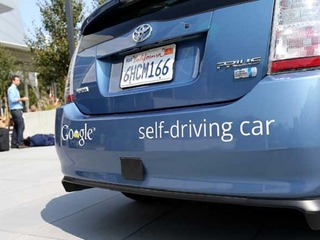The FDA outlines draft guidance on AI for medical devices
The agency also published draft guidance on the use of AI in drug development
Read more...
Google has been battling to get its self-driving cars out on the road, despite some pushback from regulators and lawmakers. Now the company seems to have just won a major victory in making that dream a reality.
The company wrote a letter to the National Highway Traffic Safety Administration in November, asking the agency to "interpret a number of provisions in the Federal Motor Vehicle Safety Standards (FMVSSs) as they apply to Google's described design for motor vehicles that it is in the process of developing and testing."
Now the agency has responded, and it has determined that, no, the cars do not actually need a human behind the wheel. In fact, they went as far as to declare the car itself the driver.
"NHTSA will interpret 'driver' in the context of Google's described motor vehicle design as referring to the (self-driving system), and not to any of the vehicle occupants," the letter from NHTSA said. "We agree with Google its (self-driving car) will not have a 'driver' in the traditional sense that vehicles have had drivers during the last more than one hundred years."
Given the design of the car, there could be no human driver, since there would be no steering wheel or brake pedals and so the, "human occupant would not be capable of actually driving the vehicle as described by Google."
"If no human occupant of the vehicle can actually drive the vehicle, it is more reasonable to identify the driver as whatever (as opposed to whoever) is doing the driving. In this instance, an item of motor vehicle equipment, the SDS, is actually driving the vehicle." (SDS stands for Self-Driving System)
This definition of what a driver is flies in the face of other proposed regulations, specifically those proposed by the California Department of Motor Vehicles in December, which would require a licensed driver to be behind the wheel at all times, in case a human needed to take over. What the NHTSA is essentially saying here is that Google does not need to even have all the amenities that would allow a human driver to even take over in case of an emergency.
Of course, the NHTSA is a federal agency, and the California Department of Motor Vehicles is a state agency, so this might become a battle over state versus federal law. In other words, this might get ugly/
It should be noted that data also bears out the necessity of a human driver, as a report put out by Google itself showed. Over the course of a year, there were over 300 times where human drivers had to take over, and 13 times when a driver prevented an accident. If there was no human in the car, it would have crashed.
The potential safety and regulation of self-driving cars is a contentious issue, but one that those in the space have been trying to confront.
Volvo for example, said that the company "will accept full liability whenever one if its cars is in autonomous mode."
Håkan Samuelsson, president and chief executive of Volvo Cars, also urged the United States to establish federal guidelines for the technology, rather than doing it on a state by state basis.
Google has also tried to take the lead by filing a patent for how self-driving cars will be able to communicate with pedestrians, basically using censors to figure out what to do, then using signaling devices to declare its intentions. For example, the vehicle might use physical signaling device, an electronic sign or lights, or a speaker to tell pedestrians what it is going to do.
VatorNews reached out to Google for comment on this ruling. We will update this story if we learn more.
(Image source: techradar.com)
The agency also published draft guidance on the use of AI in drug development
Read more...The biggest focus areas for AI investing are healthcare and biotech
Read more...It will complete and submit forms, and integrate with state benefit systems
Read more...
